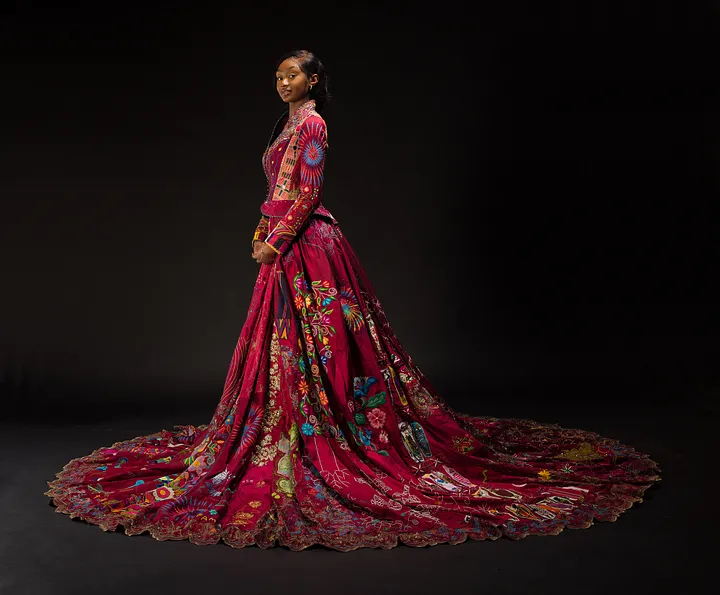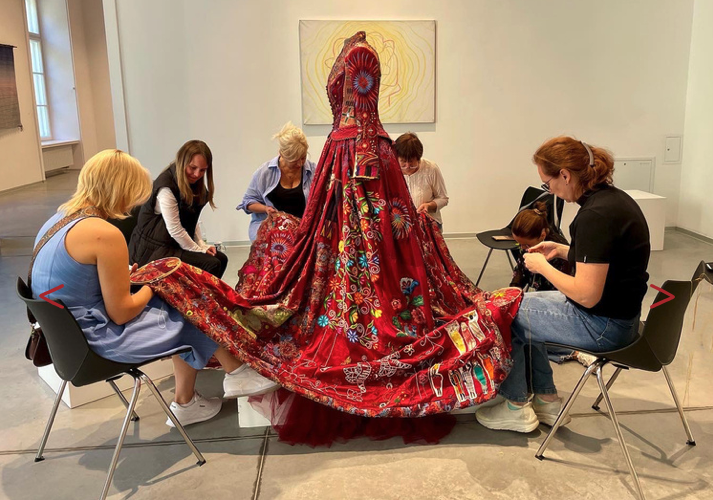Redefining Fashion Through Technology and Sustainability
The Digital Red Dress Case Study

When fashion often struggles with being sustainable, the Digital Red Dress project comes forward as a strong message, blending technology and art. The Red Dress Project, a creative effort led by British artist Kirstie Macleod, is more than just a piece of clothing; it stands as a symbol of hope, strength, and individual expression for women from many places. This special project has involved over 367 artists from 51 countries to contribute their skills, making one shared artwork that, in our opinion, touches the core of the human experience in the fashion industry.
According to a piece published on Sustainable Fashion Week, the dress symbolizes the liberation from the material world, showcasing that fashion can be both ephemeral and impactful. It highlights the need for a shift in consumer mindset, one that accept digital creation as a viable alternative to the traditional garment industry.
The Transition in to the Digital Realm
This project recently made a bold move into the digital world with support from Bath Spa University and the artist. Led by Dr. Coral Manton, using advanced 3D scanning and retopology techniques they made a 3D digital copy of the Red Dress.
The team utilised advanced digital embroidery techniques to create intricate patterns and textures that can only exist in a digital realm. As Coral Ann Manton articulates in her Medium article, the project’s visual appeal lies in its ability to capture the viewer’s imagination while provoking critical conversations about sustainability.
These technologies not only capture the intricate details and textures of the dress but also significantly reduce the carbon footprint associated with physical exhibitions by enabling virtual displays. The digital transformation makes the project reachable to people all over the world through the internet and also aligns with ideas of being eco-friendly and slow fashion, essential in today’s rapidly changing industry.

“The Digital Red Dress began as a response to the urgent need to raise awareness about gender-based violence and reproductive healthcare,” says Dr. Manton. “When I was approached to create a digital replica for the Lost Horizon festival in Bristol, I knew this was an opportunity to support a crucial cause.”
The creation process was full of passion, with Dr. Manton collaborating with skilled colleagues Richard Wood and Fred Reed to bring this vision to life. During the quiet holiday season, they transformed the physical dress into a digital format, ensuring that its impactful story reaches even more individuals.
Embroidery as Expression

Since its formation in 2009, the Red Dress has become a platform for individuals, primarily women, living in vulnerable situations, allowing them to share their stories through embroidery. The garment, crafted from 87 pieces of burgundy silk dupion, has traveled the world, continuously embroidered by a diverse group of 367 women, 11 men, and 2 non-binary artists. This collaborative effort reflects the rich tapestry of experiences that span cultures, backgrounds, and struggles.
What began as an exploration of identity through the art of embroidery has evolved into a powerful mean for self-expression. Each stitch tells a unique story, from female refugees from Palestine and Syria to survivors of war from Kosovo and Rwanda. Many embroiderers are skilled professionals, while others are newcomers to the craft, finding solace and purpose in their art.
“This project has given women a platform to reclaim their narratives,” notes Macleod. “It’s about empowerment through creativity and the belief that every story deserves to be told.”
Continuing the Journey
The Red Dress Project has been showcased in renowned galleries and museums worldwide, from the National Library of Kosovo to the Fashion and Textile Museum in London. As it continues on its next phase of journey, the dress will continue to travel, aiming to reach the countries of its commissioned embroiderers and showcase their work alongside it.

With ongoing support from various charities and social enterprises, the Red Dress Project ensures that the voices of these artists are amplified in the world. Practical assistance has come from organizations like Manchester Aid for Kosovo and the War Childhood Museum in Bosnia & Herzegovina, emphasizing the collective commitment to supporting women in need.
Looking Ahead: A Future of Accessibility and Empowerment
As this project moves forward, it will maintain a strong online presence, allowing individuals worldwide to engage with its story. By offering an accessible platform, the project aims to inspire others to explore their creativity and share their experiences.
“Through this project, we’re not just creating art; we’re building a community,” Kirstie Macleod asserts. “Each stitch connects us, reminding us that we are part of a larger story that deserves recognition and celebration.”
The Red Dress is important for showing how people working together can make something powerful, and it also reminds us of the strong spirit of women all over the world. As this dress travels further, it asks everyone to join in this global story, adding a little bit one stitch at a time.
For more insights on this project, you can explore the full articles on Red Dress Embroidery and Sustainable FashionWeek.